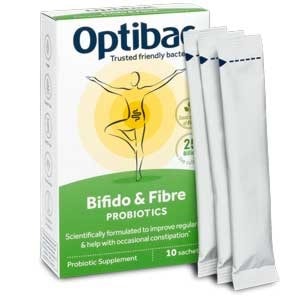You are on the US site
Hello UK customer, you are currently shopping on the US site. To ensure you are charged in the correct currency and receive accurate shipping costs, please switch to the UK website and re-add your product to your basket.
You're away from FREE US delivery Free US delivery (applied at checkout) on orders over $60.00
You have qualified for Free US delivery
About Probiotics
What is Bifidobacterium?
Bifidobacterium is a genus of probiotic bacteria found mainly in the large intestine. This FAQ answers all of your questions about Bifidobacterium.
In this article we explain:
- What does Bifidobacterium do?
- Where is Bifidobacterium found?
- Which is the best Bifidobacterium supplement?
- How much Bifidobacterium should you take?
- Which foods contain Bifidobacteria?
There are many different strains of bacteria in the Bifidobacterium genus (the plural is Bifidobacteria, which you may come across too). A genus is a ‘family’ of friendly bacteria and within the Bifidobacterium genus there are several species, including Bifidobacterium infantis, Bifidobacterium lactis, and Bifidobacterium breve.
Each species of Bifidobacterium has different strains, such as the highly researched Bifidobacterium Lactis BB-12, all with specific characteristics and functions in the body. The best way to ensure that you are taking the right types of friendly bacteria to suit you is by looking at the specific strains within a live cultures supplement. Read about the difference between bacteria species and strains to find out more.
What does Bifidobacterium do?
We are often asked ‘is Bifidobacteria harmful or helpful?’ And the answer is a resounding ‘helpful’!
Functions of the Bifidobacterium genus are varied and unique, as with all bacteria, depending on the exact strain. For example, the following strains have been extensively researched and found to offer health benefits for a range of conditions:
Bifidobacterium lactis BB-12® is well-known to improve bowel regularity1
Bifidobacterium breve M-16V® can improve eczema2 and allergic symptoms3,4 in infants.
Bifidobacterium lactis HN019 has been shown to improve intestinal transit time8 and overall digestive health.
Bifidobacterium lactis Bl-04® is known to support immune health10 and improve allergic symptoms in children with hay fever11.
Bifidobacterium infantis 35624 can help with mood and behavioural issues9.
Additionally, there are some common characteristics of Bifidobacterium strains, one of which being their ability to break down complex carbohydrates in the gut. Lactic acid is produced as a result of the fermentation process, which lowers the pH level of the gut and helps to prevent harmful bacterial growth.
Research has also found that Bifidobacterium strains tend to play a role in boosting overall immunity and are essential in maintaining a healthy digestive tract. The actions of Bifidobacteria make it possible for other species to exist and thrive. Acetate, a short-chain fatty acid (SCFA) produced by Bifidobacteria, nourishes other bacteria that produce butyrate, a short-chain fatty acid that feeds the gut lining and prevents inflammation.
Where is Bifidobacterium found?
Bifidobacteria (sometimes referred to as Bifido) is found mainly in humans and animals. It is the most common genus of bacteria in the infant gut microbiome, being the first bacteria to colonise the intestinal tract as babies pass through the birth canal. From birth up until around the age of 3 years old Bifidobacterium bacteria comprise the largest percentage of an infant’s gut microbiome. After this time levels dramatically decrease to adult levels of about 5% of the gut microbiome5.

Which is the best Bifidobacterium supplement?
As already explained, there are many different strains of Bifidobacterium. The best supplement for you is the one that contains strains suitable for your specific needs.
In addition, when choosing the best Bifidobacterium live cultures supplement, check that the strain has sufficient scientific evidence to support its survival in the gut and the condition you want to support.
Our products which contain strains of Bifidobacteria are:
- Every Day
- Every Day EXTRA
- Every Day MAX
- Bifido & Fibre
- One Week Flat
- Babies & Children
- Baby Drops
- Pregnancy
How much Bifidobacterium should you take?
That all depends on why you are taking a probiotic supplement. Some conditions require a higher quantity (billions count) than others in order to be effective. How much Bifidobacterium you take is also age dependent, as in the case of babies and children.
Remember that a higher billions count does not necessarily equal higher quality – it’s most important to get the right strains, even if they’re in lower quantities.
For example, the recommended intake for our Baby Drops product is eight drops daily while for Bifido & Fibre the initial dosage of one sachet daily can be increased to up to four sachets daily if required.
Always follow the manufacturer guidance on the packet.
Which foods contain Bifidobacteria?
Many foods are abundant in Bifidobacterium, including yoghurt and milk products.
Foods rich in fibre, such as apples, dates, lentils, blueberries, and broccoli, can all help your Bifidobacterium thrive, so are well worth including in your daily diet.
A diet low in fibre is associated with lower bacterial variety and abundance, whereas a diet rich in these non-digestible carbohydrates increases Bifidobacteria and Lactobacilli in the gut.
All fermented foods are sources of Bifidobacteria, particularly milk kefir, sourdough bread, sauerkraut, kimchi and other fermented vegetables. Fermented foods containing lactic acid bacteria, such as cultured milk and yoghurt products, have been found to increase levels of Bifidobacteria and Lactobacilli.
You can read more about Lactobacillus in our FAQ What is Lactobacillus? Read more about fermented foods over on the Probiotics Learning Lab.
Further reading:
Healthcare practitioners might be interested to find out more about Bifidobacterium on the Probiotics Database, on our Probiotic Professionals site.
This FAQ was answered by Helen Morton, Nutritional Therapist DipION
References:
- Eskesen, D. et al. (2015), ‘Effect of the probiotic strain Bifidobacterium animalis subsp. lactis BB-12® on defecation frequency in healthy subjects with low defecation frequency and abnormal discomfort: a randomised, double-blind, placebo-controlled, parallel-group trial’, British Journal of Nutrition, Nov 28: 114(10) :1638–1646.
- Hattori K et al. (2003). Effects of administration of bifidobacteria on faecal microflora and clinical symptoms in infants with atopic dermatitis . Arerugi, 5, 387.
- Taniuchi S et al. (2005). Administration of Bifidobacterium to infants with atopic dermatitis: changes in faecal microflora and clinical symptoms. The Journal of Applied Research, 5 (2): 387-396.
- Ezaki et al. (2012). Prophylactic probiotics reduce cows milk protein intolerance in neonates after small intestine surgery and antibiotic treatment presenting symptoms that mimics postoperative infection. Allergology International, 61 (1): 107-113.
- Roger LC et al., "Examination of faecal Bifidobacterium populations in breast- and formula-fed infants during the first 18 months of life.," Microbiology, vol. 156, no. 11, pp. 3329- 3341, 2010.
- Boon Wong C (2022) https://www.foodingredientsfirst.com/news/breakthrough-morinaga-milk-study-sheds-light-on-bifidobacteria-impact-on-hmos-and-infant-gut-microbiome.html
- Zakharova I.N., Berezhnaya I.V., Skorobogatova E.V. Fermented milk-based baby drinks fortified by prebiotics and probiotics: impact on the health of infants and young children. Russian Journal of Woman and Child Health. 2022;5(3):253–261 (in Russ.).
- Waller, P. A. et al., (2011) ‘Dose-response effect of Bifidobacterium lactis HN019 on whole gut transit time and functional gastrointestinal symptoms in adults’. Scandinavian Journal of Gastroenterology. 1057–1064
- Desbonnet L. et al (2008), ‘The probiotic Bifidobacteria infantis: an assessment of potential antidepressant properties in the rat’, Journal of Psychiatric Research, 43(2):164-74.
- Turner et al., (2017) ‘Effect of probiotic on innate inflammatory response and viral shedding in experimental rhinovirus infection – a randomised controlled trial’ Beneficial Microbes, 8(2): 207-215
- Ouewhand et al, (2009) ‘Specific probiotics alleviate allergic rhinitis during the birch pollen season’, World Journal of Gastronenterology, 15: 3261-3268.
